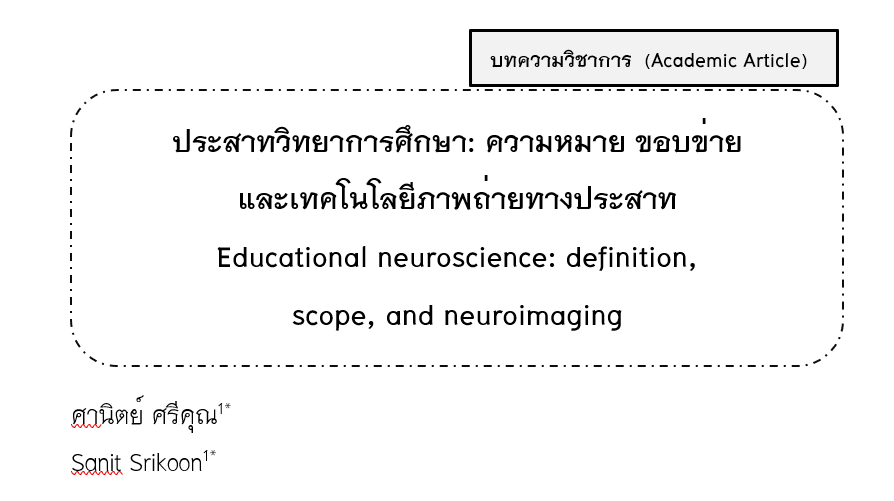Educational Neuroscience: Definition, Scope, and Neuroimaging
Keywords:
Neuroimaging, Neuroscience, Education, Educational NeuroscienceAbstract
There has been the evolution and advances of neuroimaging technologies, for example, FMRI which can be used to study the processes of the nervous system by measuring differences in electromagnetic properties of blood and EEG which can measure the brain’s electrical activity based on the sum total of the electrical activity of each neuron. This has led to a more accurate body of knowledge about the learning process with scientific empirical evidence. As a result, it has contributed to the combination of sciences, thus developing a new field referred to as “Educational Neuroscience”. This field is a multidisciplinary science between psychology, education, and neuroscience, which aims to shed clear light on the learning process, to transcend learning limitations, and to create educational innovations with reliability and more accuracy. This integration of sciences is implemented on an ideological level, e.g., theories, ideals, and values, which amalgamate different sciences, a practice level, including methods and environment/society, and an outcome level.
References
เกศราพรรณ คงเจริญ. (2559). การพัฒนารูปแบบการเรียนการสอนเสริมสร้างสมรรถภาพการสอนตามแนวคิดการฝึกหัดทางปัญญาสําหรับนักศึกษาวิชาชีพครู. วารสารมนุษยศาสตร์และสังคมศาสตร์ มหาวิทยาลัยพะเยา, 4(3), 12-27.
จตุภูมิ เขตจัตุรัส, ทัศนีย์ บุญเติม, จินตนาภรณ์ วัฒนธร. (2558). การสังเคราะห์องค์ความรู้เกี่ยวกับเครื่องมือวัดสมรรถนะสมองด้านพุทธิปัญญา. ขอนแก่น: มหาวิทยาลัยขอนแก่น.
ทัศนีย์ บุญเติม, จักรกฤษณ์ สําราญใจ, จุติมา เมทนีธร, .จินตนาภรณ์ วัฒนธร, .สุภาพร มัชฌิมะปุระ, ปณคพร วรรณานนท์, สุวิทย์ อุปสัย, ศานิตย์ ศรีคุณ และ ศิริพร วีระชัยรัตนา. (2558). การพัฒนาซอฟต์แวร์วัดสมรรถนะสมองด้านพทธิปัญญาฉบับภาษาไทย ด้านความตั้งใจ และ ความจำขณะทำงาน. ขอนแก่น: มหาวิทยาลัยขอนแก่น.
ราตรี สุดทรวง. (2539). ประสาทสรีรวิทยา (พิมพ์ครั้งที่ 3). กรุงเทพฯ: สำนักพิมพ์จุฬาลงกรณ์มหาวิทยาลัย.
วรสิทธิ์ ศิริพรพาณิชย์. (2556). การประเมินความตั้งใจจดจ่อด้วยการตรวจคลื่นไฟฟ้าสมองและการประยุกต์ใช้ในเด็กที่เป็นโรคซนสมาธิสั้น. วารสารการแพทย์และวิทยาศาสตร์สุขภาพ, 20(1), 4-12.
วิทย์ วิศทเวทย์. (2544). ปรัชญาการศึกษาไทย 2411-2545. กรุงเทพฯ: สำนักพิมพ์แห่งจุฬาลงกรณ์มหาวิทยาลัย.
ศานิตย์ ศรีคุณ. (2562). การตรวจสอบความตรงเชิงทฤษฎีของซอฟแวร์แบบวัดความสามารถเชิงพุทธิปัญญาในมิติความถูกต้อง. วารสารศึกษาศาสตร์ มหาวิทยาลัยขอนแก่น, 42(4), 103-117.
ศานิตย์ ศรีคุณ. (2563). การตรวจสอบความตรงเชิงโครงสร้างของซอฟแวร์แบบวัดความสามารถเชิงพุทธิปัญญาในมิติเวลา ของนักเรียนระดับชั้นมัธยมศึกษาปีที่ 3.วารสารปัญญาภิวัฒน์, 12(3), 229-243.
ศานิตย์ ศรีคุณ. (2563ข). การพัฒนารูปแบบการสอนที่เน้นการฝึกความจำขณะทำงานโดยใช้ประสาทวิทยศึกษาศาสตร์เป็นฐานเพื่อส่งเสริมความสามารถเชิงพุทธิปัญญาและผลสัมฤทธิ์ทางการเรียนคณิตศาสตร์ของนักเรียน. วารสารมนุษย์ศาสตร์และสังคมศาสตร์ มหาวิทยาลัยนครพนม, 10(3), 105-114.
สุดาพร ติ๊บปาละ และศานิตย์ ศรีคุณ. (2565). ผลการใช้กิจกรรมการเรียนรู้โดยใช้วิธีการแบบเปิดร่วมกับการฝึกเชิงพุทธิปัญญาเพื่อเสริมสร้างการคิดวิเคราะห์ของนักเรียนชั้นมัธยมศึกษาปีที่ 3 โรงเรียนวังเหนือวิทยา จังหวัดลําปาง. วารสารมนุษยศาสตร์และสังคมศาสตร์ มหาวิทยาลัยพะเยา, 10(1), 61-85.
ส. ศิวรักษ์. (2516). ปรัชญาการศึกษา (พิมพ์ครั้งที่ 2). กรุงเทพฯ: สำนักพิมพ์ เคล็ดไทย.
สำนักงานคณะกรรมการการศึกษาแห่งชาติ. (2542). พระราชบัญญัติการศึกษาแห่งชาติ พ.ศ. 2542. กรุงเทพฯ: พริกหวานกราฟฟิค จำกัด.
สำนักงานราชบัณฑิตยสภา. (2554). พจนานุกรม ฉบับราชบัณทิตยสถาน พ.ศ. 2554. สืบค้น 24 สิงหาคม 2564, จาก https://dictionary.orst.go.th/index.php.
Anderson, M. (2007). The Massive Redevelopment Hypothesis and Functional Topography of the Brain. Philosophical Psychology, 20(2), 144-149.
Bright Brain Centre. (2021). EEG and Brain Waves. Retrieved September 7, 2021, from https://www.brightbraincentre.co.uk/electroencephalogram-eeg-brainwaves/.
Aspinall, P., Mavros, P., Coyne, R., and Roe, J. (2013). The urban brain: analysing outdoor physical activity with mobile EEG. British Journal of Sports Medicine, 49(4), 272–276.
Byrnes, J.P. and Vu, L.T. (2015). Educational Neuroscience: Definitional, Methodological, and Interpretive Issues. WIREs Cogn Sci, 6(1), 221-234.
Cambridge University. (2021). Cambridge Dictionary. Retrieved August 24, 2021, from https://dictionary.cambridge.org/dictionary/english/neuroscience.
Dick, F., Lloyd-Fox, S., Blasi, A., Elwell, C. and Mill, D. (Mareschal, D., Butterworth, B. and Tolmie, A., Editor). (2014). Neuroimaging Methods. Educational Neuroscience. United Kingdom: Jonhn Wiley & Sons, Ltd.
Duszyk, A., Dovgialo, M., Pietrzak, M., Zieleniewska, M., and Durka, P. (2019). Event-Related Potentials in the Odd-Ball Paradigm and Behavioral Scales for the Assessment of Children and Adolescents with Disorders of Consciousness: A Proof of Concept Study. The Clinical Neuropsychologist, 33(6031), 1–19.
Feiler, J.B. and Stabio, M.E. (2018). Three Pillars of Educational Neuroscience from Three Decades of Literature. Trends in Neuroscience and Education, 13(1), 17-25.
Goswani, U. (2004). Neuroscience and Education. British Journal of Educational Psychology, 74(1), 1-14.
Jamaludin, A., Henik, A. and Hale, J.B. (2019). Educational Neuroscience: Bridging Theory and Practice. Learning and Research Practice, 5(2), 939-998.
Kamel, N. and Jatoi, M.A. (2018). Brain Source Localization Using EEG Signal Analysis. New York: Taylor & Francis Group.
Kamel, N. and Malik, A.S. (2015). EEG/ERP Analysis: Method and Applications. New York: Taylor & Francis Group.
Klingberg, T., Forssberg, H., Westerberg, H. (2002). Training of Working Memory in Children With ADHD. Journal of Clinical and Experimental Neuropsychology (Neuropsychology, Development and Cognition: Section A), 24(6), 781–791.
Mareschal, D., Butterworth, B. and Tolmie, A. (2014). Educational Neuroscience. United Kingdom: John Wiley & Sons.
Specht, K. and Grüner, R. (2021a). Bergen fMRI Group. Retrieved September 7, 2021, form https://www.uib.no/en/rg/fmri.
Specht, K. and Grüner, R. (2021b). Bergen fMRI Group. Retrieved September 7, 2021, form https://www.uib.no/en/rg/fmri/108133/methodology#functional-magnetic-resonance-imaging-nbsp-fmri-nbsp-.

Downloads
Published
How to Cite
Issue
Section
License
Copyright (c) 2022 Phayao University

This work is licensed under a Creative Commons Attribution-NonCommercial-NoDerivatives 4.0 International License.
ผู้นิพนธ์ต้องรับผิดชอบข้อความในบทนิพนธ์ของตน มหาวิทยาลัยพะเยาไม่จำเป็นต้องเห็นด้วยกับบทความที่ตีพิมพ์เสมอไป ผู้สนใจสามารถคัดลอก และนำไปใช้ได้ แต่จะต้องขออนุมัติเจ้าของ และได้รับการอนุมัติเป็นลายลักษณ์อักษรก่อน พร้อมกับมีการอ้างอิงและกล่าวคำขอบคุณให้ถูกต้องด้วย
The authors are themselves responsible for their contents. Signed articles may not always reflect the opinion of University of Phayao. The articles can be reproduced and reprinted, provided that permission is given by the authors and acknowledgement must be given.







